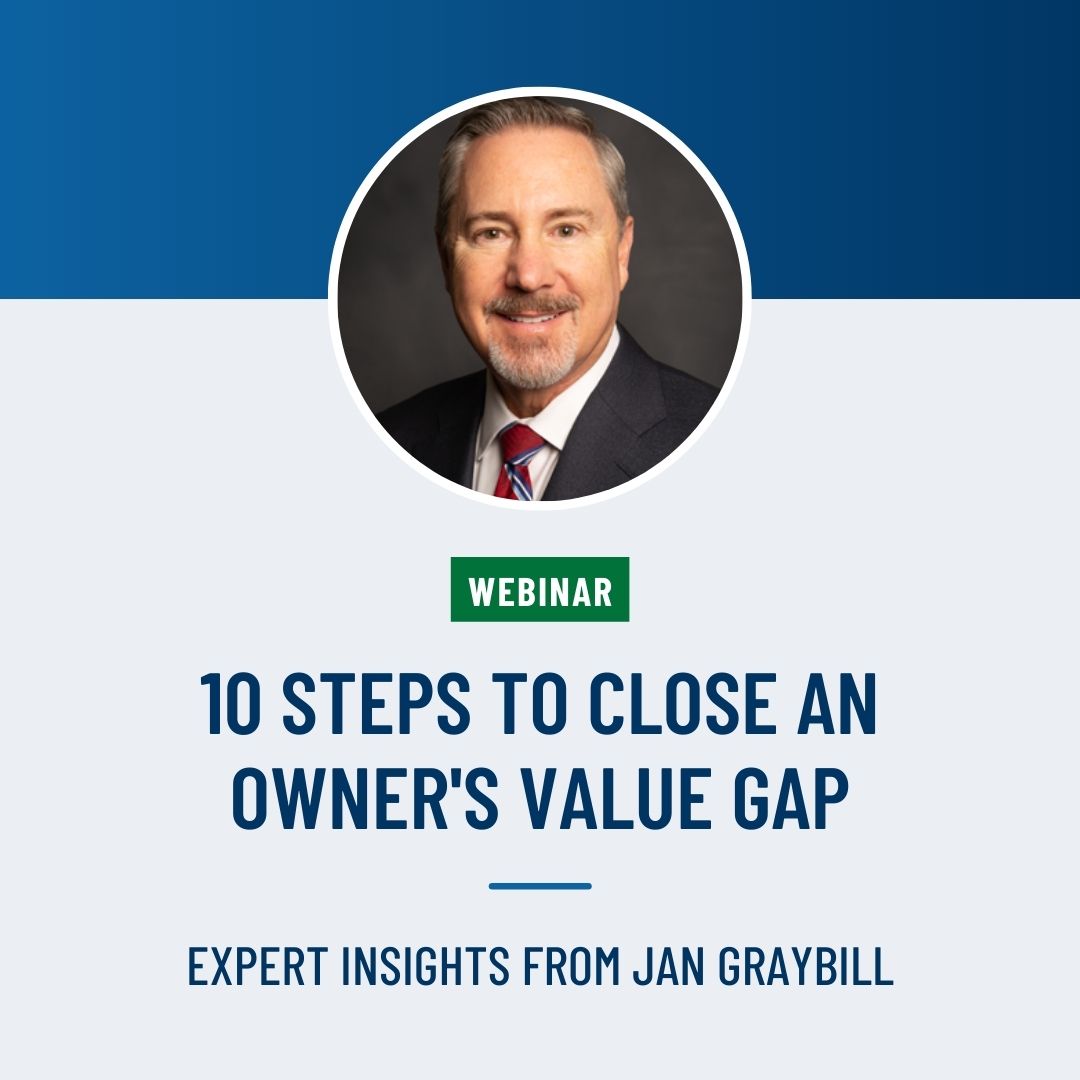
THE EXIT PLANNING BLOG
Keep up-to-date with exit planning, succession planning, industry trends, unique specialty insights, and useful content for professional advisors and business owners.
Share this
10 Steps to Close An Owner’s Value Gap
by Colleen Kowalski on August 30, 2022

When working with business owner clients, advisors play a crucial role in understanding business value and how that impacts the salability of the business. The Exit Planning Institute recently hosted a webinar with Jan Graybill, CEO and Managing Partner of Legacy Planning Partners. Jan highlighted the necessary role CEPAs play in providing business owners with holistic exit planning and closing the owner’s value gap.
He shares, “Everything you do as a CEPA revolves around building and retaining assets for an owner exiting their business. You will improve an owner’s quality of life, their business success, and their legacy for their family, business partners, and successors.”
Meet Jan Graybill
As CEO and Managing Partner Jan Graybill is committed to a client experience that is goal focused and planning-driven.
Utilizing his 40+ years of experience as a financial advisor, Jan helps guide clients through business and life cycle transitions to pursue their financial goals.
Since its founding in 1999, Legacy Planning has developed a specialization in four key areas of financial decision-making: business owner succession planning, family office consulting, corporate retirement plan services, and comprehensive financial planning. Completing our holistic approach, we seek to collaborate with current trusted advisors to maximize the effectiveness of your financial decisions.
Jan has a Master of Science in Financial Services from The American College, and a business degree from Millersville University. In addition, he is a Certified Financial Planner™ professional (CFP®) and a Certified Exit Planning Advisor (CEPA®).
Jan and his wife, Alisa, reside in the Lehigh Valley close to their two daughters and their five grandsons. In addition, they are very proud of their daughters’ ongoing contributions to Legacy Planning’s success as they have both been employees now for over a decade.
What is a Value Gap?
Jan Graybill starts each owner engagement by asking owners one question. “Do you know your number?” This number is the amount the owner will need to survive after they exit their business. Most owners have a general idea of what their finances must look like to successfully live the next phase of their life. However, they might not understand how close or far from that “number” they truly are.
To determine an owner’s Value Gap, you must first understand their Wealth and Profit Gaps. The difference between the amount of money your business is worth based on a valuation and the amount of money you need to sustain an enjoyable third act is known as the Wealth Gap. An owner’s Profit Gap is the difference between the amount of profit their business currently earns and what they could earn if performing at best-in-class levels.
An owner’s Value Gap is the difference between the value in the business now and the potential value of their business if they were to perform at best-in-class levels in relation to EBITDA. Understanding an owner’s three gaps allows for an exit planning advisor to prepare a plan for building value and meeting the owner’s desired wealth goal.
10 Steps to Close The Value Gap
So, how do you close the Value Gap and create lasting, transferable value in an owner’s business? Jan discussed 10 steps toward closing a Value Gap. He discusses these steps with his owner clients and uses them as the framework for building sustainable value.
1. Review Your Estate Plan
What would happen to your family if you were no longer here? Do you have a detailed estate plan in place that covers your family in case of an emergency?
2. Create an Emergency Management Plan
Now, consider your business. What would happen to it if you never showed up to work again? Do you have the proper steps and plans in place should you suffer from an accident or pass away?
3. Institute a Board of Directors or Advisory Board
Do you have a board of directors or an advisory board in place in your business? If so, are they objective third-party professionals?
4. Obtain a Range of Values For The Business
Have you gotten a proper valuation of the business in the past year? A valuation will act as a starting point to close the Value Gap.
5. Score The Business on Attractiveness and Readiness
Have you completed an owner readiness and business attractiveness assessment? These assessments will show you where your business ranks in terms of best-in-class value in your industry and determines how much personal planning you have done to prepare for the transition.
6. Calculate The Annual Income Needed For You and Your Spouse to Live Your Life
Have you determined your “number?” Do you know how much after-tax income you will need to live off of in your next act? This determines if you understand your Wealth Gap.
7. Determine Total Dollar Value Needed to Generate The Ideal Income After Exit to Meet The High Likelihood of Success
If you were to exit your business today, would your business provide enough to fill that Wealth Gap? What does your business need to be worth to meet your goals?
8. Compare The Total Dollar Number to The Amount of Total Assets Today
When combining your total business value and the value of your assets, did you successfully meet your Wealth Goal? If not, what can be done in your business, either by increasing your EBITDA or growing your multiple, to build that value?
9. Define The Company’s Leadership Team
Who is on your leadership team in your business? Do you seek advice from this team? If you do not have a leadership team, your business may be too dependent on your successes. This is a topic of conversation moving forward.
10. Define The Company’s Management Team
Do you have a defined management team or employees on a management track? What are their main responsibilities and daily duties? If you do not have a management team in place, and you as the owner are the main operational head of the business, this is an opportunity for coaching to take place.
Learn more about the Three Gaps in an Owner’s Business in our 5-4-3-2-1 Whitepaper.
Follow our socials for more exit planning content and strategies.
Share this
- Blog (520)
- CEPA (367)
- exit planning (243)
- CEPA community (181)
- Business Owner (135)
- Exit Planning Summit (85)
- EPI Chapter Network (82)
- Exit Planning Partner Network (76)
- EPI Announcement (49)
- Content (48)
- Value Acceleration Methodology (46)
- Webinars (37)
- Excellence in Exit Planning Awards (32)
- Marketing (30)
- 2024 Exit Planning Summit (28)
- 5 Stages of Value Maturity (26)
- Books (24)
- Exit Planning Teams (22)
- EPI Team (21)
- 2023 Exit Planning Summit (20)
- Leadership (20)
- family business (19)
- women in business (19)
- Intangible Capital (18)
- Exit Options (17)
- Black Friday (16)
- EPI Academy (16)
- CPA (15)
- State of Owner Readiness (14)
- Chapters (12)
- Chris Snider (12)
- National Accounts (12)
- Small business (12)
- Walking to Destiny (12)
- charitable intent (12)
- personal planning (12)
- Financial Advisors (9)
- 5 Ds (8)
- About us (8)
- Podcast (8)
- Insiders Bash (7)
- Scott Snider (7)
- Christmas (6)
- Exit Planning Content Library (6)
- Case Studies (5)
- Owner Roundtables (5)
- Season of Deals (5)
- Value Advisors (5)
- financial planning (5)
- Awards (4)
- Exit & Succession (4)
- Five Ds (4)
- executive training (4)
- Circle of Excellence (3)
- Owners Forum (3)
- forbes (3)
- EPI Thought Leadership Council (2)
- Exit Is Now Podcast (2)
- Peter Christman (2)
- Three Legs of the Stool (2)
- Veteran (2)
- Whitepapers (2)
- author (2)
- Business Owners Forum (1)
- DriveValue (1)
- business consultants (1)







